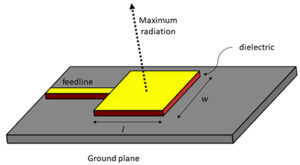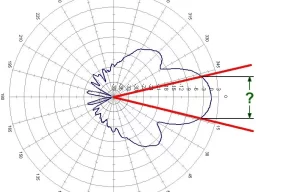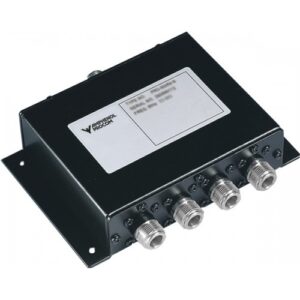Table of Contents
Atmospheric Conditions
Have you ever noticed that whenever there was heavy rain or snow outside your house and a finale of your favorite TV show or an important sports event broadcast was on, you started to see pixelation or complete loss of your satellite signal? The thing that is responsible for this annoyance is called rain fade, and it is a natural process where precipitation scatters and absorbs the microwave signals that are used to broadcast satellite signal. The satellites that are mostly affected by rain fade are the ones that broadcast at the Ku-band and the Ka-band. For instance, during a downpour, these types of satellite signals may lose strength by as much as 20 dB. To avoid these issues, satellites have to slightly reduce the power they emit, and the error-correction algorithms have to become more robust. At the same time, users can decide to install satellite dishes that have larger surfaces to reduce this energy loss. For instance, if the user chose a 90 cm satellite dish over a traditional 60 cm dish, they would lose as much as 30% less signal during inclement weather.
Standard Precautions
Everyday users do have some measures they could take to ensure that their satellite signal isn’t mixed up with the permanent structures on their property. For one, they have to make sure that their satellite dish has a proper line of sight. To avoid this effect, they should make sure that no trees or buildings are obscuring the signal. Second, users have to make sure that their satellite dish is properly aligned with their provider’s signal. Finally, users should look into performing regular maintenance checks to ensure that their dish stays in prime condition.
Signal Boosters
Another way to avoid signal loss during bad weather is to use signal amplifiers. These devices, much like phone signal boosters, strengthen the signal between the satellite dish and the receiver, allowing it to remain intact when it travels through greater distances or harsh weather.
Proper Installation
Another thing that can be done to ensure better satellite signal reception is to install the satellite dish in the highest place of the user’s property. This way, there is less in the way of the dish and the satellite, making the distance between the two as short as possible.
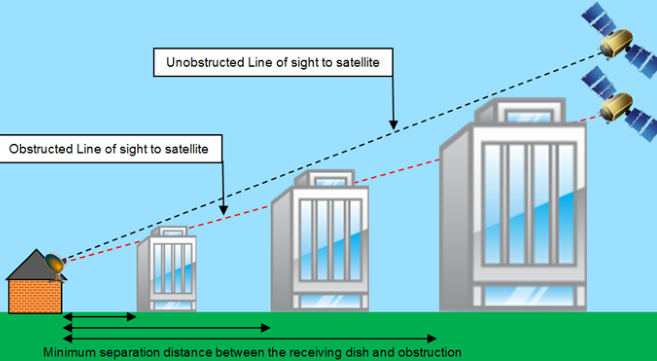
Physical Obstructions
One of the most common reasons that satellite signals get blocked is a physical obstruction. In particular, trees, buildings, and geographical features such as hills and mountains can come in the way of the satellite dish and the satellite, blocking the direct line of sight. For example, a tree that was initially at a reasonable distance from the satellite dish when it was initially set up can grow to a height of 30 feet or more, half of which will attenurate the DirecTV signal. And the result will be a reduction in quality by 50% or more.
Thus, one of the most important things that need to be done is to properly survey the site before the installation of the satellite dish and the commencement of the service. Not only should the direct route of signal between the two points b indicated, but there should also be some approximate consideration as to the growth of potential vegetation and further development of the surroundings. On the part of the users, one also should remain updated on the changes that occur locally, from the growth of vegetation to the plans to construct more nearby.
Effective Solutions
Several steps may then be taken to solve this issue. For instance, when it is impossible to change the location of the dish, one can trim the trees or ensure that their growth is adequately managed. Which such an approach, the tree will not only be kept from growing too tall but also stopped from developing a width large enough to cover some significant part of the satellite. Alternatively, the dish itself may be installed on a pole or a structure so that it gets several yards above any near obstruction. If this is also not possible, then the use of an advanced signal meter is typically recommended, as such devices will be able to properly and it in the right azimuth and elevation angle, which will maximize the reception by properly selecting the satellite’s location and the presence of obstructions. Another factor may include the strategic installation of the dish at one of the property’s sides, which is far more likely to be less obstructed than any of the other sides. For example, on the sloping roof of the house but as far away from it as possible and with less vegetation and obstacles between.
Solar Interference
Solar interference is a temporary blockage of satellite signal by the sun’s energy overwhelming the satellite’s signal to earth. It is known to occur in March and September during the equinox periods of between the 20 th to 21 st and 21 st till the 24 th. This is on the assumption that the satellite in question is geostationary and located over the equator. In these periods, the sun aligns directly behind the satellite system. The powerful solar radiation and noise simply drown off the satellite’s signal to earth. The windows for these disturbances known as solar outage windows are perfectly known by the satellite service providers. Users of any satellite in question have to expect some disturbance in the signals, which may range from a few minutes to several hours. They must be prepared for such disruptions every now and then in September and March. The solar interference may cause degraded quality of service, which may include lost active connections or total loss of the signal. Failure of a typical solar interference to any satellite signal; for instance, satellite television will undergo much pixelation longer than usual or to an extend blackout is expected onceix1. A typical solar interference is expected to last not less than 15 minutes once there is a peak in solar alignment.
Proactive Monitoring and Scheduling
The easiest way to manage solar interference is by planning for it. This is a period perfectly known in advance and the times it is likely to last are also highly predictable. Some satellite operators communicate such information to their customers and even publish the schedules they publish in their brochures. At the times of the satellite interference, do not plan to go live with any audio or video satellite-reliant activities coverages, for example, in this case. For satellite television viewers, do not plan to watch television but plan to record and watch at a different time.
Technological Adaptations
Although it is impossible to prevent solar interference or faded reception call it what you like, such information is always known way in advance. Use of satellite receivers designed with technology to combat for satellite interference effects may automatically adjust the sensitivity of the satellite receiver to accommodate more interference times. This way, the satellite receiver is more likely to lock to the satellite signal when its signal sensitivity is adjusted. In that case, the effects of solar interference may be reduced by solar signal interference to a receiver. The disadvantage of this built-in nature of the software in the satellite systems is that either the satellite interference will be attempting to block the satellite signal from earth, reason why it will always try harder until the solar interference has ended. Though half impressing with solar receiver helps receivers withstand some extent of the solar interference, after all it will always fail and its reception will fade or loose totally.
Enhanced Communication Systems
For systems that need to be in constant communication through the satellites and the applications are critical for example, direct satellite TV signals reception in the satellite TV signal relay station or emergency services that needs to be in perfectly communication with the headquarter office need to look into an alternative of using a reliable back up; in case of solar interference event satellite signal will be lost. Such alternatives may include use of direct internet services from Internet service providers or low Earth orbit satellite dishes. As earlier definitions suggest, life on earth should avoid the use of geostationary satellite systems, at any cost. It is because the system is characterized with the height of between one and a half hour up to six hours of completely lost or no signal services as we have witnessed in our discussion example. Alternatively, other satellite devices such as low Earth orbit satellite systems guarantee minimized signal disruption of either total non-existence or degradation of the quality of the satellite signal received. The height of a low Earth orbit satellite from the ground measures between four hundred and fifty and a thousand two hundred kilometers from the surface of the earth. The low Earth orbit elements are constantly moving in relation to the materials of the earth. It makes solar alignment not easily attainable by the sun. Hence, such satellite will be sending comfortable less solar interference-sensitive signals to the earth users.
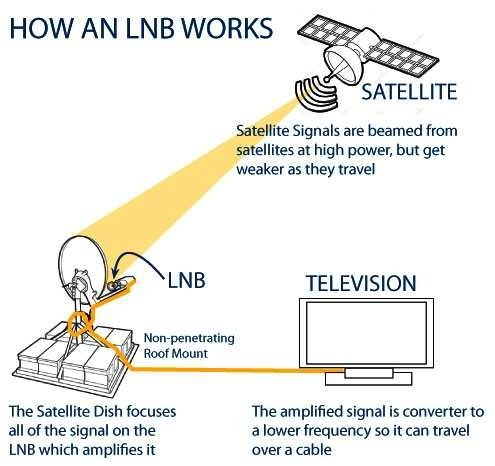
Technical Issues with the Satellite or Equipment
Technical malfunctions on the satellite impacting its quality and continuity are not the only affairs of this kind in regard to the services that satellites provide. Indeed, technical breakdown of a satellite itself may never happen, and failure in the ground equipment may be a source of failure. For instance, a transponder on the satellite – the bit of equipment that receives signals from Earth and re-transmits them back – may fail. As a result, all channels that the this particular transponder supports will experience partial or total loss of signals, depending on how many clients the transponder catered for. The companies operating the satellites constantly monitor the technical condition of their satellites and switch faulted equipment to a standby unit, but this is not always possible to do right away.
Maintenance and Upgrades Due
Equipment deterioration does depend on proper maintenance, and is also a function of time to a degree. However, wear and tear is not the only cause for technical equipment to fail. Both satellite dishes and receivers can get damaged by the weather and they can also become outdated. Regular checks no less than once in few years, will determine what parts will likely fail first, and those parts will be replaced in timely manner. For instance, replacing an old LNB that is tending to find it hard to pick a signal from the satellite’s downconvertor with a new model may increase the sensitivity of the reception. This will mean that the quality and size of the actual signal does not need to be improved; also, in case of a poor weather the dish will not require the water to be lined up properly to get its weak transmission either. It is also possible to install an adaptive model of a device sending signals, or a receiver that can adjust itself rather than needs to be manually realigned. When the signals got few strength over time or received adversely, the system can adjust its resistance as it gets weaker signal on the picture or on the sound. At the same time visual and sound qualities stay at their best. Professional services with test instruments can be used for an installation of the dish to ensure it is aligned to the satellite’s coordinates to receive the signals. Even a fraction of a grade’s error can lead to a significant drop in strength, and hence in quality of the received signal. Regular checks by these maintenance professionals, no less than once in few years, can ensure that even this will never happen.
Interference from Other Signals
In an urban or densely populated setting, signal interference typically becomes a significant issue with satellite communications. This type of interference is often emitted by electronic equipment or a different communication signal that habituates stations built close to the satellite service’s frequency. For instance, a radar station or a wireless internet router that resides near the satellite can emit another type of electromagnetic signal that will interfere with the service. It can cause an interruption in quality of the signal, which can result as an increase in error rate or signal that vanishes entirely.
Identifying and Handling Interference
To establish the source of interference, one must take action that allows them to establish the place and frequency at which interference takes place. Firstly, one could use a spectrum analyzer to monitor the frequencies at which interference occurs. Following identification, measures can be used to filter out the noise and enhance the quality of the signal. Those measures could include filtering out the frequency of the alternate signal or changing the position of the satellite dish.
Using Advanced Modulation Techniques
The satellite dish can also send a signal to the satellite that will instruct the transmitter what frequency band to target by the use of advanced modulation. However, it is important to remember that one receiver should not be using two frequency ranges as it is will be receiving a command to change the frequency to avoid cross interference from other equipment. Other than that, satellite communications also use different modulation techniques, such as TDMA and FDMA allocation of bandwidth, which also acts as a form of signal filtering.
Strategic Placement of Satellite
Placing the satellite outside of the source of the alternative signal is a good form of interference prevention. The location of the satellite dish or other electronic equipment can also be placed on an elevated plane or near the roof of the building.. Additionally, such devices as antennas or satellite dishes should not be placed in the direction of known broadcasting towers on on a hill, as they will experience interference from the sending tower.

